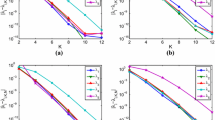Abstract
In this paper, an efficient iterative method is presented to calculate the eigenvalues of the stiffness matrices of some structures having near-regular forms. In the present method, by a suitable nodal ordering of the near-regular structures, partitioning stiffness matrices of special form and applying an effective Schur decomposition, the matrix corresponding matrices become decomposable. Then utilizing the theorem about the relation between the poles of a Schur complement equation and the eigenvalues of the submatrix and using an iteration bisection method, the eigenvalues of the stiffness matrices or the frequencies of the near-regular structure are obtained. Also utilizing the Cauchy interlacing theorem about the relation between the eigenvalues of a matrix A and eigenvalues of the matrix B obtained by striking out a row and the corresponding column of A, the proper bounded interval for eigenvalues of B becomes obtainable. Previously, for solving the eigenvalues of near-regular structures, they were approximately considered as regular ones because graph products were unable to solve the eigenvalues of these near-regular structures in a swift and exact manner. In this paper, using a combination of graph products, Schur decomposition, and the above-mentioned effective theorems together with an iteration bisection method with appropriate initial intervals, more suitable results are obtained.



Similar content being viewed by others
References
Biondi B, Muscolino G (2003) Component-mode synthesis method for coupled continuous and FE discretized substructures. Eng Struct 25:419–433
Fang H, Wang TJ, Chen X (2011) Model updating of lattice structures: a substructure energy approach. Mech Syst Signal Proc 25:1469–1484
Kalantzis V, Li R, Saad Y (2016) Spectral Schur complement techniques for symmetric eigenvalue problems. Electron Trans Numer Anal 45:305–329
Kangwai RD, Guest SD (2000) Symmetry-adapted equilibrium matrices. Int J Solids Struct 37:1525–1548
Kangwai RD, Guest SD, Pellegrino S (1999) An introduction to the analysis of symmetric structures. Comput Struct 71:671–688
Kato T (1976) Perturbation theory for linear operators. Springer, New York
Kaveh A (2013) Optimal analysis of structures by concepts of symmetry and regularity. Springer, New York
Kaveh A, Fazli H (2011) Approximate eigensolution of locally modified regular structures using a substructuring technique. Comput Struct 89:529–537
Kaveh A, Nemati F (2011) Efficient free vibration analysis of rotationally symmetric shell structures. Commun Numer Methods Eng 27:541–552
Kaveh A, Rahami H (2006) Block diagonalization of adjacency and laplacian matrices for graph product; applications in structural mechanics. Int J Numer Methods Eng 68:33–63
Kaveh A, Rahami H (2007) Compound matrix block diagonalization for efficient solution of eigenproblems in structural mechanics. Acta Mech 188:155–166
Kaveh A, Rahami H (2010) An efficient analysis of repetitive structures generated by graph products. Int J Numer Methods Eng 84:108–126
Kaveh A, Rahami H, Mehanpour H (2012a) Static and modal analyses of structures with different repeated patterns. Adv Eng Softw 51:1–9
Kaveh A, Rahami H, Pezeshky P (2012b) A new block tri-diagonal stiffness matrix for efficient finite element analysis of structures. Asian J Civ Eng 13:257–273
Kaveh A, Rahami H, Mirghaderi SR, Ardalan Asl M (2013) Analysis of near-regular structures using the force method. Eng Comput 30:21–48
Kaveh A, Rahami H, Jodaki A (2017) Analysis of repetitive and near-repetitive structures by transformation to equivalent circulant structures. Eng Comput 34(2):343–363
Law SS, Yong D (2011) Substructure methods for structural condition assessment. J Sound Vib 330:3606–3619
Lui SH (1998) Kron’s method for symmetric eigenvalue problems. J Comput Appl Math 98:35–48
Shojaei I, Kaveh A, Rahami H (2013) Analysis of structures convertible to repeated structures using graph products. Comput Struct 125:153–163
Zingoni A (2009) Group-theoretic exploitations of symmetry in computational solid and structural mechanics. Int J Numer Methods Eng 79:253–289
Zingoni A (2012) Symmetry recognition in group-theoretic computational schemes for complex structural systems. Comput Struct 94(95):34–44
Zingoni A (2014) Group-theoretic insights on the vibration of symmetric structures in engineering. Philos Trans R Soc A 372:20120037
Author information
Authors and Affiliations
Corresponding author
Rights and permissions
About this article
Cite this article
Kaveh, A., Pishghadam, M. & Jafarvand, A. Frequencies of Some Near-Regular Structures: A Combined Graph Product and Bisection Method. Iran J Sci Technol Trans Civ Eng 43 (Suppl 1), 159–170 (2019). https://doi.org/10.1007/s40996-018-0192-2
Received:
Accepted:
Published:
Issue Date:
DOI: https://doi.org/10.1007/s40996-018-0192-2




